

Since its inception, JBJS has stood above other medical journals for its editorial excellence. JBJS Editors-in-Chief and Deputy Editors have always been committed to the rigorous fact-checking, line editing, and manuscript reviews required of a leading scientific journal.
It is the mission of JBJS, Inc. “to improve musculoskeletal health across the globe by delivering gold-standard information resources for clinicians, researchers, and orthopaedic care teams,” and this focus on delivering high-quality information is reflected in the meticulous copy-editing of every JBJS article.
During his tenure from 1952-2000, Steve Tilton was a talented, dedicated and beloved contributor to JBJS.
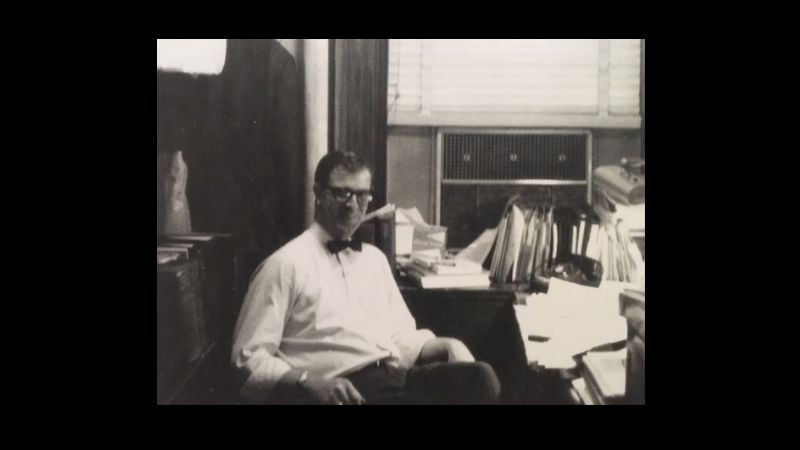
Steve Tilton went to college at Colby, in Maine, and was a second-generation conscientious objector who served in the American Field Service in World War II, as his father had in World War I. Mr. Tilton drove an ambulance in North Africa, Italy, and Germany. After the war, it seems he had had his fill of excitement in motorized vehicles, and he never drove again. He taught English at Beirut University for a time, then came to Boston to attend BU for a graduate degree in English literature, but did not enjoy being back in school and did not stay long. He started at JBJS in 1954. He arrived on time at the office, lunched always at 11:30, read the Boston Globe at his desk after lunch, and never worked past closing time.
He was a homebody, and when asked what he planned to do on his spring vacation, he was known to mention that he might venture out to Harvard Square in Cambridge, around two miles from his home; however, he really enjoyed the bi-annual trips to England to meet with the British once those trips began in the 70’s or 80’s.
He retired from his role as Managing Editor in 1998 and worked part-time for JBJS as Manager of the Journal of Orthopaedic Research. He officially retired in 2000.

The Annual Bibliography of Orthopaedic Surgery is an index of articles that have significant value to orthopaedic surgeons. Articles are chosen by an Advisory Committee made up of the American Orthopaedic Association and JBJS.


Before the widespread use of PCs, the JBJS publication process involved manually checking references, pen-and-ink editing, re-typing manuscripts, cutting-and-pasting layouts, and snail-mailing submissions, review copies, and proofs.
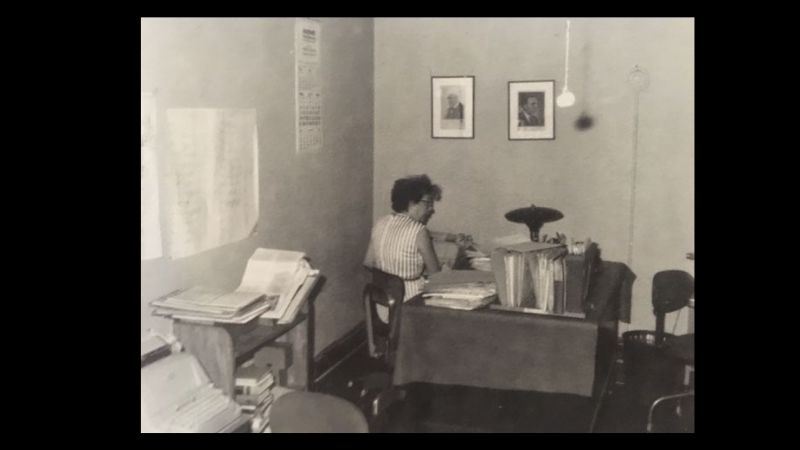
“Until the late 1970s, the process of publishing an issue of JBJS and getting it into the hands of subscribers was a laborious one.
After acceptance, each manuscript underwent a 3-day process of meticulous line editing, manual reference checking, and retyping of the entire manuscript.
The printing process was also time-consuming. Once assigned, articles were shipped to the printer, where they were rekeyed and typeset before being sent back to JBJS for proofreading. The hard-copy proof was then read, corrected, and shipped back to the printer to create the final copy, which was again proofread to make sure that all changes had been incorporated correctly.
Layout artists then proceeded to cut up the printed pages and lay them out onto sheets to mimic the final appearance in the full printed Journal before shipping the pages back to the printer, who finalized proofs for final proofreading before printing the full Journal.”

Appointed in 1958, Dr. Brown was a humble leader who set a high standard for editorial excellence and was devoted to the communication of scientific material. During his tenure as Editor-in-Chief, he inculcated the controlled article structure that remains today.
JBJS launched Orthopaedic Transactions to recognize the significant contributions of leading orthopaedic researchers and to make their articles available to a larger audience of peers who were not able to attend specialty conferences in person.
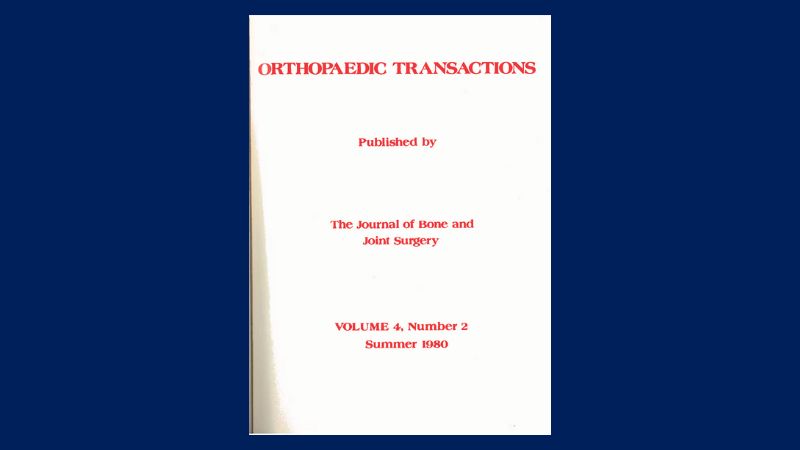

To meet orthopaedists’ demand for review articles, JBJS moved from occasional review articles to regularly published articles that were planned in advance and edited in a more systematic way, resulting in a regular, high-quality special section.
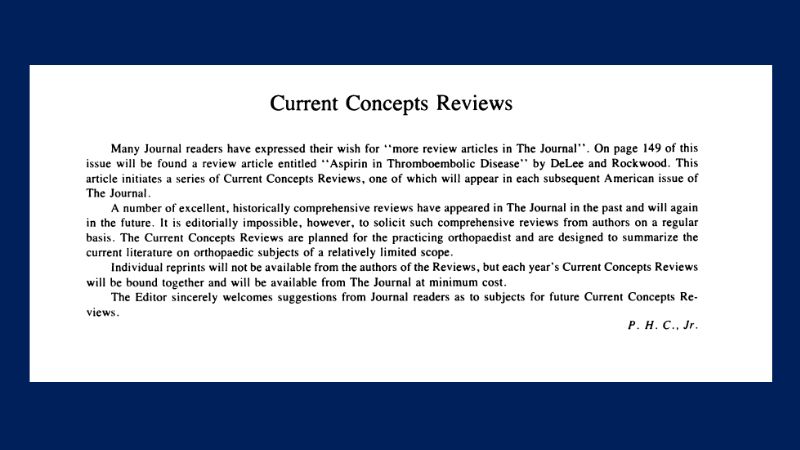

Following an intrinsic belief that the perception of bias should be eliminated, JBJS began a blind peer review process that continues today. Manuscripts that clearly identify authors are returned without review.
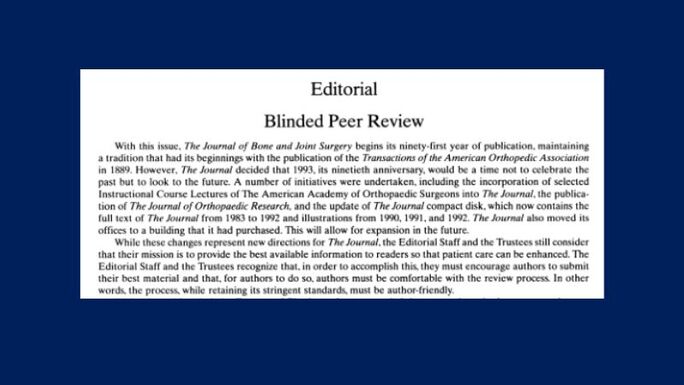
JBJS Editorial Staff and Trustees recognized that to support the JBJS mission, the Journal must encourage authors to submit their best material. For authors to do so, it was imperative that they be comfortable with the review process, which should follow stringent standards in an author-friendly way.
Some authors felt that an author’s perceived status—based on their institution and location—might affect whether a manuscript was rejected or accepted. While no such bias was proven, the Journal believed that even the perception of bias should be eliminated and therefore instituted a blind peer review process.
Starting in July 1994, manuscripts were required to be submitted with two cover sheets: one that contained author names and contact information and a second to be sent to reviewers with only the manuscript title.

Under Dr. Heckman’s tenure as Editor-in-Chief, JBJS enhanced the level of evidence published with clinical articles and implemented structured abstracts. During this time, JBJS also launched several new features, including “Orthopaedic Forum,” “Ethics in Practice,” “Evidence-Based Orthopaedics,” and “Specialty Update.”
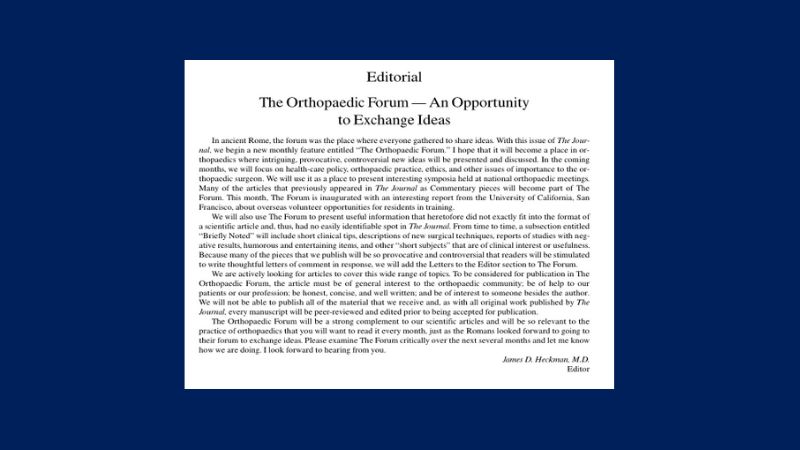
The “Orthopaedic Forum” is designed to be a place where intriguing, provocative, or controversial new ideas are presented and discussed. It includes topics on health care policy, orthopaedic practice, and ethics, and presents interesting symposia from national orthopaedic meetings.
“Ethics in Practice” articles feature topics of benefit to both physicians and patients alike. Typically, each article includes a brief clinical vignette followed by a discussion of the ethical issues that were encountered and how they were addressed.
“Evidence-Based Orthopaedics” articles, published quarterly, feature summaries of the main points of 3 recent studies from the orthopaedic literature, followed by commentaries highlighting the strengths and weaknesses of each study from an evidence-based perspective.“
Specialty Update” articles, published monthly, provide a comprehensive overview of the recent literature pertaining to major subspecialties in the field of orthopaedics.

Dr. Greene appointed and promoted James Heckman as Editor-in-Chief and Mady Tissenbaum as the General Manager of JBJS, Inc. On December 31, 2002, the Board of Trustees froze the Defined Benefit Plan.

Also under Dr. Greene’s guidance, the agreement to make JBJS a member benefit of the AAOS was officially implemented. After a long-standing relationship, the separation of the American and British versions of The Journal of Bone and Joint Surgery began.
During his tenure, Dr. Greene reaffirmed the ongoing mission of JBJS for excellence in scientific publishing and encouraged the discussion of other alternative educational opportunities.

Dr. Weinstein instituted a submission fee for JBJS scientific articles and formed the Editor-in-Chief Search Committee which was formed to replace retiring Editor-in-Chief Vernon Tolo, MD.

Dr. Weinstein also approved the Peer Review Evaluation Score (preSCORE) initiative to give readers insight into the peer review process around individual articles.
Marc Swiontkowski, MD, was selected by the Editor-in-Chief Search Committee as the next Editor-in-Chief in December 2013.

Under Dr. Gelberman’s leadership, JBJS entered its first significant publishing agreement with Wolters Kluwer Health, effective beginning 2016. Dr. Gelberman also authorized the asset acquisition of the Journal of Orthopaedics for Physician Assistants, now JBJS JOPA.

Dr. Gelberman also helped reorganize editorial roles at JBJS. He replaced Kent Anderson as CEO/Publisher and then split the responsibilities of the role. Mady Tissenbaum was promoted to Publisher, and Paul Sandford as CEO of JBJS, Inc., in August 2014.
Additionally, JBJS began the use of SocialCite for citation processing. Editorial assets further evolved as the SocialCite project was terminated in December 2014. JBJS preSCORE assets were also sold, and the organization changed its brand back to JBJS, Inc. from Striatus Orthopaedic Communications, Inc. Moving forward, JBJS would focus on the orthopaedic market prospectively.

In January 2016, JBJS implemented an Elite Reviewers Program to formally recognize the outstanding contributions of our very best reviewers. Elite Reviewers are recognized based on measurements of their response time, quality of reviews, and reliability.
Peer review is the basic underpinning of scientific publication, and The Journal’s reviewers are key components in our 127-year history of publishing the highest quality of evidence-based information. JBJS reviewers volunteer their time and expertise to serve the orthopaedic community and enhance the quality of care for patients.
To formally recognize the outstanding contributions of our very best reviewers, beginning in January 2016, JBJS will implement an Elite Reviewer Program. Elite Reviewers will be recognized based on measurements of their response time, quality of reviews, and reliability.
We expect that authors will benefit from the program with even higher-quality and more prompt peer review, and we hope the program inspires all of our reviewers to meet Elite Reviewer standards.
For more information about the program, read the JBJS editorial, or visit the Elite Reviewers Program page on our website.

Sign up to receive your free JBJS 2020 Special Issue—a compilation of the most-read articles. You get twelve articles across six JBJS publications in this special issue.